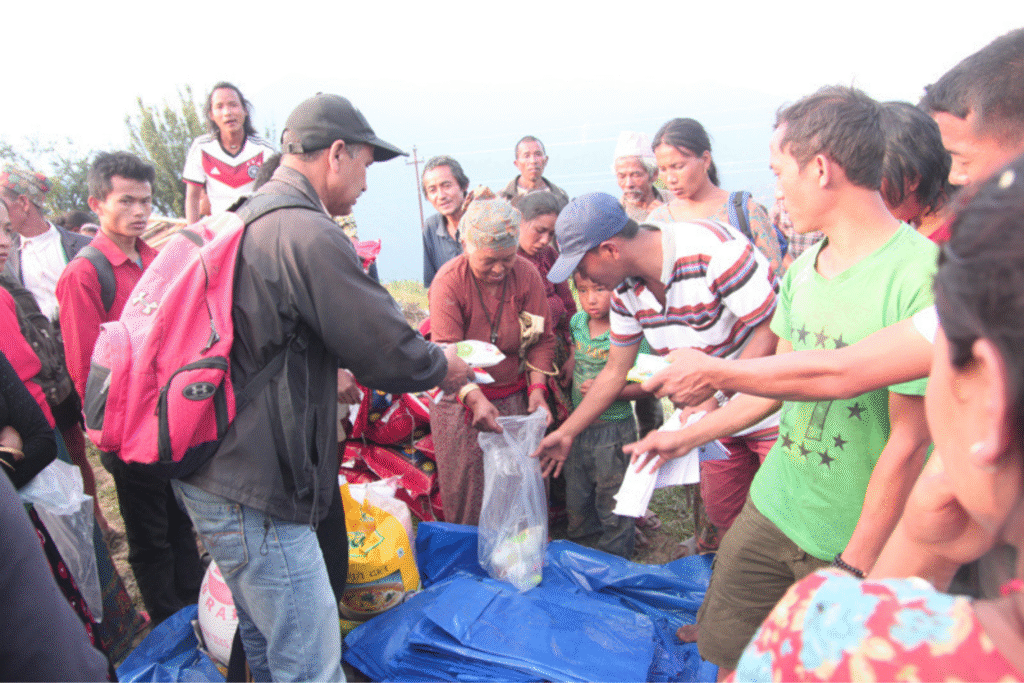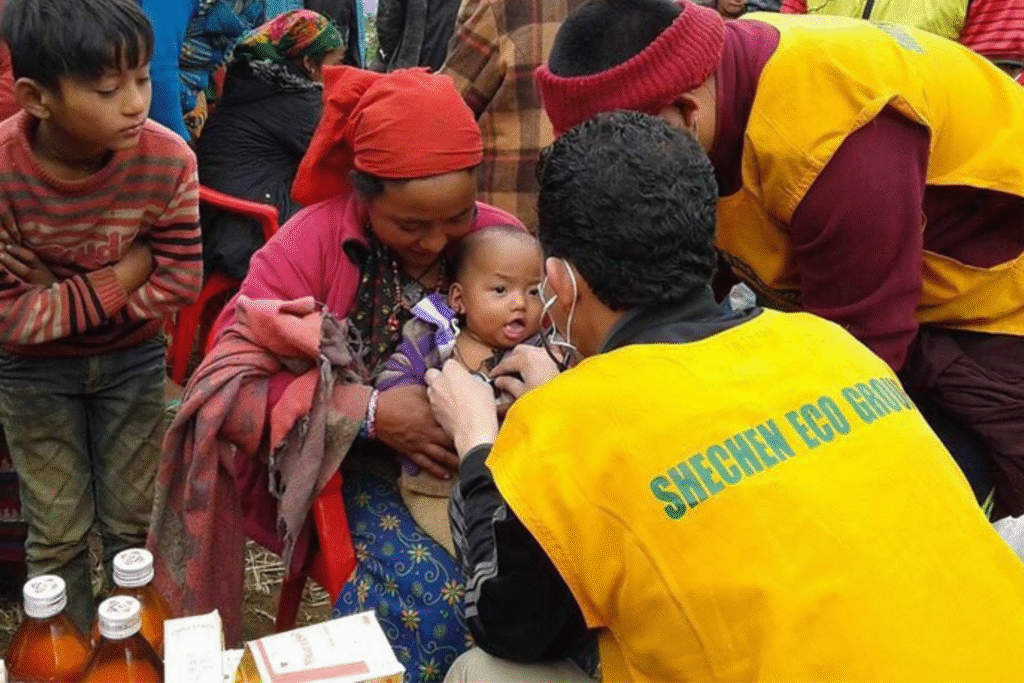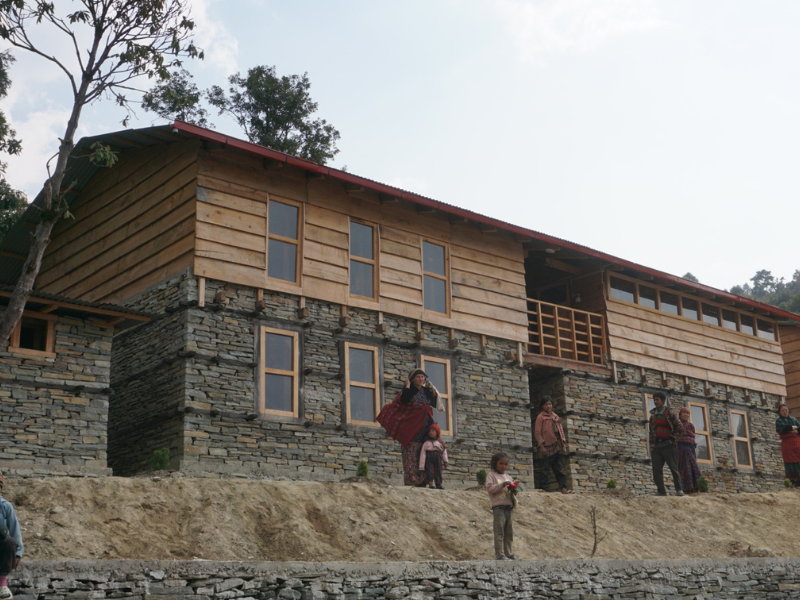A national trauma
On April 25, 2015, a magnitude 7.8 earthquake struck Nepal. Two weeks later, a major aftershock of magnitude 7.3 occurred. In the months that followed, numerous secondary tremors, albeit of lesser intensity, continued to shake the affected regions: some caused further damage, others completed the destruction of what the first tremors had weakened. Affecting nearly 8 million people and 39 districts out of 75 at the time, this earthquake left an indelible mark on the Himalayan country.
The disaster left in its wake immeasurable human and material losses: 8,773 dead, 23,304 injured and almost 2.8 million displaced. More than 785,000 homes, 446 health facilities destroyed and 765 partially damaged, as well as heavily damaged educational and cultural infrastructures, bear witness to a landscape battered by the violence of nature.



Multidimensional consequences
The earthquake has had a profound impact on Nepal’s economy and environment, as well as causing loss of life. Damage was estimated at 7 billion dollars, representing around 33% of GDP in 2015.
In the agricultural sector, the impact is also measured in staggering figures. The loss of 135,200 tonnes of food was added to the disappearance of 560,000 animals, mostly poultry, representing a loss of nearly 284 million dollars. These losses have pushed more than half a million people below the poverty line, marking an abrupt break in traditional livelihoods.
At the same time, the earthquakes and their aftershocks significantly altered the beds of various rivers in Nepal. As a result, water networks have been severely damaged, leading to numerous short- and medium-term difficulties in accessing water.
In the face of the emergency, compassion set into motion
From the very first hours after the earthquake, Karuna-Shechen mobilized with great responsiveness to respond to the humanitarian emergency. Exceptional aid was deployed in 15 of the worst-affected districts, covering essential needs: mobile clinics, distribution of food, temporary shelters and blankets. Given the scale of the needs, post-earthquake activities were rapidly extended to more than 58 villages, marking a lasting presence alongside the stricken communities.

Karuna-Shechen was able to rely on close collaboration with local NGOs to carry out these activities. Birendra Kumar Singh, the clinic’s administrative manager at the time, recalls: “Karuna-Shechen collaborated with two other organizations during the response, which was crucial given our limited human resources at the time. One was INHURED International, which helped us with the distribution of relief materials. The other was LOOKS Nepal, which served as an implementing partner for Karuna-Shechen, particularly in school reconstruction and associated educational initiatives.“
Despite this relentless commitment, action on the ground was hampered by chaotic logistics, heightened social tensions and landslides that isolated entire communities. Crowd control, already delicate, sometimes became impossible, while ever-increasing transport costs made every delivery more complicated. Added to this was the precarious state of the roads, often impassable, which slowed or even prevented the delivery of emergency and post-emergency aid. Against this backdrop of instability, successive aftershocks maintained a climate of urgency and fear that weighed on every gesture of solidarity.

Despite these difficulties, compassion remained the guiding principle. Bimshen Raut Chetri, Karuna’s driver since 2013, shares :

It was an emotional experience. Even though I had my own family to think about, I continued to work during those difficult days. Being able to help others in such devastating times made me stronger and more courageous, and gave me real meaning in my life.
Bishmen Raut Chetri
Priority to education and health
Education and health were at the heart of our action. Karuna – Shechen has rebuilt ten schools in twelve districts using prefabricated, earthquake-resistant structures. As Birendra explains, “In many areas, the schools had been totally destroyed. Children were studying in the open air, exposed to the elements.” Returning to school offered children the stability, social ties and normalcy essential to their equilibrium.
On the health front, medical campaigns, support for pregnant women and the distribution of medicines met urgent needs.
Our timely medical support has significantly improved maternal and general health in many remote areas.
Birendra, administrative manager of the Shechen clinic



Finally, the scale of the psychological trauma, particularly in rural areas lacking mental health support, confirmed the importance of an integrated, humanistic approach to reconstruction.
After the emergency, Karuna-Shechen took long-term action, aware that true reconstruction was not limited to rebuilt walls, but was rooted in social cohesion, access to fundamental rights and people’s autonomy.
Crossed perspectives: the words of Sébastien
At the time consultant for Karuna, Sébastien is now the Director of Communication and Fundraising.

“In 2015, Karuna was several independent groups of volunteers in the various branches, apart from the salaried teams in India and Nepal. The earthquake in Nepal was a real shock, and it was the first time the association had faced an emergency. What was incredible was that all Karuna members then worked together, buoyed by the surge of generosity that followed Matthieu’s appeal. In just two months, we raised the equivalent of a whole year’s worth of donations. Thanks to all these donations, Karuna was able to deploy an ambitious three-year post-emergency plan. All these achievements and the increased notoriety gave us the desire and the means to perpetuate our work, structure our teams and professionalize the association. Two years later, we set up a new governance structure with the election of a Chairman and the appointment of an Executive Director, and the organization’s headquarters were established in France. Personally, this period left its mark on me, not only emotionally, but also professionally.“
What are the lessons and challenges today?
Persistent difficulties
Ten years after the earthquake, Nepal continues to face major structural challenges. The disaster highlighted the absence of disaster preparedness plans, the ineffectiveness of some public and international aid, and endemic social inequalities.
Marginalized communities, notably Dalits and indigenous groups, have been particularly hard hit: less than half of them received full reconstruction grants in 20221. Many rural areas are also still waiting to be rebuilt, and housing, social equity and environmental preservation are among the unfinished projects.
In the field, Karuna-Shechen has observed that, where it operates, essential infrastructure – schools, health centers and water networks – remain in the form of temporary facilities that have become permanent due to a lack of follow-up. This compromises the resilience of communities and slows down any return to normal life. This is particularly true of many of the schools rebuilt in the emergency: they remain as they were, without permanent foundations or reliable access to water.
Building for the long term
As Bimshen points out, “Even after the emergency response faded from collective memory, Karuna-Shechen continued its support. We never stopped. Karuna-Shechen’s support for poor and marginalized communities during a period of deep crisis was its greatest contribution.” This loyalty to commitment has been embodied in concrete, sustainable projects that go far beyond immediate aid.
Karuna’s teams have implemented projects to strengthen the resilience of community infrastructures in the face of earthquakes. For example, the Kharsa school, built in collaboration with French architects and local craftsmen from 2021, is an earthquake-resistant structure adapted to the region’s climatic conditions. It provides a safe and stimulating learning environment for children, while actively involving the community in its design and construction.



This project is part of a response to a persistent observation: even ten years after the earthquake, many schools rebuilt in the emergency had remained as they were, with no lasting infrastructure or reliable access to water. The Kharsa school illustrates our determination to build for the long term.
Similarly, in Khaniyabas and in our other intervention locations, Karuna-Shechen equipped several establishments with a drinking water supply system, which had been deprived of it since the 2015 earthquakes. Once again, this was a response to a structural deficiency left without a lasting solution after the crisis.
Rebuilding hope, cultivating resilience
Since 2022, nationwide, 90% of the homes destroyed in the earthquake have been rebuilt, along with over 7,000 schools and 1,200 health facilities. In addition, the return of international travellers, reconnecting with Nepal’s cultural richness, bears witness to the renewed confidence and solidarity.
Driven by a profoundly humanist vision, Karuna-Shechen is honoured to contribute in its own small way to the reconstruction of such a culturally rich country, and to accompany its rural communities towards a more resilient and united future.
Our thoughts go out to all those affected by the earthquakes, both near and far; their strength and resilience continue to guide our every step.
You too can be part of this long-lasting wave of solidarity.
- Amnesty International. (2022). Equity in Recovery: Nepal’s Unfinished Agenda.
↩︎